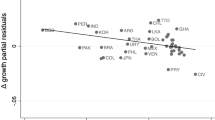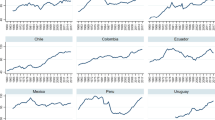Abstract
This paper examines the impact of trade liberalisation on the long-run economic development as measured by the real GDP per capita in Turkey. Based on the ‘endogenous’ growth theory, we employ bivariate and multivariate cointegration analyses to test the long-run relationship among the relevant variables. Results for Turkey suggest a stable, joint long-run relationship among real GDP per capita, an index of trade liberalisation, human and physical capital in accordance with the ‘endogenous’ growth theory. Statistically significant error-correction terms provide further evidence that those variables are indeed cointegrated. This also implies causal effects.
Similar content being viewed by others
References
Agarwala, R. (1983), ‘Price distortions and growth in developing countries’,World Bank Staff Working Paper No.515, World Bank, Washington DC.
Agenor, P.R. and Taylor, M.P. (1993), ‘The causality between official and parallel exchange rates in developing countries’,Applied Financial Economics, 3, 255–266.
Ahmad, A. and Kwan, C.C. (1991), ‘Causality between exports and economic growth’,Economics Letters, 37, 243–248.
Aricanli, T. and Rodrik, D. (eds.) (1990a),The Political Economy of Turkey: Debt Adjustment and Sustainability, Macmillan, London.
Arrow, K.J. (1962), ‘The economic implications of learning by doing’,Review of Economic Studies, 29, 155–173.
Arslan, I. and van Wijnbergen, S. (1993), ‘Export incentives, exchange rate policy and export growth in Turkey’,The Review of Economics and Statistics, 75(1), 128–133.
Bahmani-Oskooee, M. and Alse, J. (1993), ‘Export growth and economic growth: An application of cointegration and error-correction modelling’,The Journal of Developing Areas, 27, 535–242.
Balassa, B. (1988), ‘The interaction of factor and product market distortions in developing countries’,World Development, 11, 2.
Balkir, C. (1993), ‘Turkey and the European Community: foreign trade and direct foreign investment in the 1980s’, in C. Balkir and A.M. Williams (eds.),Turkey and Europe, Pinter, London.
Banerjee, A., Dolado, J., Galbraith, J.W., and Hendry, D.F. (1993),Cointegration, Error-Correction and the Econometric Analysis of Non Stationary Data, Oxford University Press, Oxford.
Barro, R. (1991), ‘Economic growth in a cross-section of countries’,Quarterly Journal of Economics, 106, 407–444.
Barro, R. and Sala-i-Martin (1992), ‘Convergence’,Journal of Political Economy, 100, 223–251.
Baysan T. and C. Blitzer (1991), ‘Turkey’ in Michaely et al. (eds.),Liberalising Foreign Trade, World Bank, Basil Blackwell, Cambridge, MA.
Bewley, R. (1979), ‘The direct estimation of the equilibrium response in a linear dynamic model’,Economics Letters, 3, 357–361.
Bhagwati, J. (1978),Anatomy and Consequences of Exchange Control Regimes, Ballinger Publishing Co. for NBER, Cambridge, MA.
Blangiewicz, A. and Charemza, W.W. (1990), ‘Cointegration in small samples: empirical percentiles, drifting moments, and customized testing’,Oxford Bulletin of Economics and Statistics, 52, 303–315.
Blough, S.R. (1988), ‘On the impossibility of testing for unit roots and cointegration in finite samples’,Working Paper, No. 211, Department of Economics John Hopkins University.
Bradford, C.I. (1987), ‘Trade and structural change: NICs and next tier NICs as transitional economies’,World Development, 15, 1.
Charemza, W.W. and Deadman, D.F. (1992),New Directions in Econometric Practice, Edward Elgar, England.
Clements, M.P. and Mizon, G.E. (1991), ‘Empirical analysis of macroeconomic time series: var and structural models’,European Economic Review, 35, 887–932.
Cuthbertson, K., Hall, S.G. and Taylor, M.P. (1992),Applied Econometric Techniques, Philip Allan, New York.
Dollar, D. (1992), ‘Outward-oriented developing economies really do grow more rapidly: evidence from 95 LDCs, 1976–1985’,Economic Development and Cultural Change, 40, 523–544.
Easterley, W.et al. (1993), ‘Good policy or luck?’,Journal of Monetary Economics, 32, 459–483.
Edwards, S. (1989), ‘Openness, outward orientation, trade liberalisation and economic performance’,Working Paper No. 2908, NBER, Cambridge, MA.
Edwards, S. (1992), ‘Trade orientation, distortions and growth in developing countries’,Journal of Development Economics, 39, 31–57.
Edwards, S. (1993), ‘Openness, trade liberalisation, and growth in developing countries’,Journal of Economic Literature, 31, 1358–1393.
Engle, R.F. and Granger, C.W.J. (1987), ‘Cointegration and error-correction: representation, estimation and testing’,Econometrica, 55, 251–276.
Engle, R.F. and Granger, C.W.J. (eds) (1991),Long-run Economic Relationships: Readings in Cointegration, Oxford University Press, New York.
Feder, G. (1982), ‘On exports and economic growth’,Journal of Development Economics, 12, 59–73.
Ghatak, S. and U. Utkulu (1993), ‘Trade Orientation and Economic Growth: The Turkish Evidence, 1955–1990: A Co-integration Analysis’, Dept. of Economics DP 93/11, University of Leicester, U.K.
Ghatak, S. and U. Utkulu (1994), ‘Exchange Rate Distortions and Real Exports in Turkey: A Cointegration and Error-Correction Analysis’, Leicester University Economics Dept, DP.
Giles, D.E.A., Giles, J.A. and McCann, E. (1993), ‘Causality, unit roots and export-led growth: the New Zealand experience’,Journal of International Trade and Economic Development, 1, 195–218.
Granger, C.W.J. (1969), ‘Investigating causal relations by econometric models and cross spectral methods’,Econometrica, 37, 424–438.
Granger, C.W.J. (1986), ‘Developments in the study of cointegrated economic variables’,Oxford Bulletin of Economics and Statistics, 48(3), 213–228.
Granger, C.W.J. (1988), ‘Some recent developments in a concept of causality’,Journal of Econometrics, 39, 199–211, esp. p. 204.
Greenaway, D. (1993), ‘Liberalising foreign trade through rose tinted glasses’,Economic Journal, 103, 208–222.
Greenaway, D. and D. Sapsford (1993), ‘Liberalisation and the terms of trade in Turkey: a causal analysis’, CREDIT 93/3, University of Nottingham, UK.
Haug, A.A. (1993), ‘Residual based tests for cointegration: a Monte Carlo study of size distoritions’,Economic Letters, 41, 345–351.
Inder, B. (1993), ‘Estimating long-run relationships in economics: a comparison of different approaches’,Journal of Econometrics, 57, 53–68.
Johansen, S. (1988), ‘Statistical analysis of cointegrating vectors’,Journal of Economic Dynamics and Control, 12, 231–254.
Johansen, S. and Juselius, K. (1990), ‘Maximum likelihood estimation and inference on cointegration: with application to the demand for money’,Oxford Bulletin of Economics and Statistics, 52, 169–210.
Jones, J.D. and D. Joulfaian (1991), ‘Federal Government Expenditures and Revenues in the Early Years of the American Republic,’Journal of Macroeconomics, 13(1), 133–155.
Kamin, S.B. (1993), ‘Devaluation, exchange controls, and black markets for exchange rates in developing countries’,Journal of Development Economics, 40, 151–169.
Kazgan, G. (1993), ‘External pressures and the new policy outlook’, in C. Balkir and A.M. Williams (eds),Turkey and Europe, Pinter, London.
Krueger, A. (1978), Liberalization Attempts and Consequences, Ballinger, New York.
Kwon, J.K. (1986), ‘Capital utilisation, economies of scale and technical change in the growth of total factor productivity: an explanation of South Korean manufacturing growth’,Journal of Development Economics, 24, 1.
Leamer, E. (1984),Sources of International Comparative Advantage, MIT Press, Cambridge, MA.
Leamer, E. (1988), ‘Measures of openness’, in R. Baldwin (ed.)Trade Policy and Empirical Analysis, University of Chicago Press, Chicago.
Lee, J. (1993), ‘International trade, distortions and long-run economic growth’, IMF Staff Papers, 40(2), 299–328.
Lucas, R.E. (1988), ‘On the mechanics of economic development’,Journal of Monetary Economics, 22, 3–42.
Mankiew, N.G., Romer, D. and D. Weil (1992), ‘A contribution to the empirics of growth’,Quarterly Journal of Economics, May, 407–437.
Miller, S.M. (1991), ‘Monetary dynamics: an application of cointegration and error-correction modeling’,Journal of Money, Credit and Banking, 23(2), 139–154.
Milner, C. (1994), ‘Real exchange rate concepts and the measurement of trade liberalisation: some evidence for Mauritius’. Paper presented to Workshop on Trade (University of Nottingham).
Muscatelli, V.A. and Hurn, S. (1992), ‘Cointegration and dynamic time series models’,Journal of Economic Surveys, 6(1), 1–43.
Pierce, D.A. and Haugh, L.D. (1977), ‘Causality in temporal systems: characterizations and a survey’,Journal of Econometrics, 5, 265–293.
Quah, D. and Rauch, J.E. (1990), ‘Openness and the rate of economic growth, Working Paper, University of California, San Diego.
Riedell, J. (1988), ‘Strategy wars: the state of debate on trade and industrialisation in developing countries’, Paper Presented at a Symposium in Honour of J.N. Bhagwati, Erasmus University, Rotterdam, November 1988.
Rivera-Batiz, L. and Romer, P. (1991), ‘International trade with endogenous technical change’,European Economic Review, 35, 971–1001.
Romer, P.M. (1986), ‘Increasing returns and long-run growth’,Journal of Political Economy, 94, 1002–1038.
Romer, P.M. (1990), ‘Endogenous technological change’,Journal of Political Economy, 98, S71–102.
Schwert, W.G. (1987), ‘Effects of model specification on tests for unit roots in macroeconomic data’,Journal of Monetary Economics, 20, 73–103.
Sengupta, J. (1991), ‘Rapid growth in NICs in Asia: tests of new growth theory for Korea’,Kyklos, 44(4).
Sengupta (1993), ‘Growth in NICs in Asia’,Journal of Development Studies, 342–357.
Solow, R. (1956), ‘A contribution to the theory of economic growth’,Quarterly Journal of Economics, 70, 65–94.
Urbain, J.P. (1993),Exogeneity in Error Correction Models, Lecture Notes Lecture Notes in Economics and Mathematical Systems, No. 398, Springer-Verlag.
Zellner, A. (1988), ‘Causality and causal laws in economics’,Journal of Econometrics, 39, 7–21.
Author information
Authors and Affiliations
Rights and permissions
About this article
Cite this article
Ghatak, S., Milner, C. & Utkulu, U. Trade liberalisation and endogenous growth: Some evidence for Turkey. Econ Plann 28, 147–167 (1995). https://doi.org/10.1007/BF01263635
Issue Date:
DOI: https://doi.org/10.1007/BF01263635




